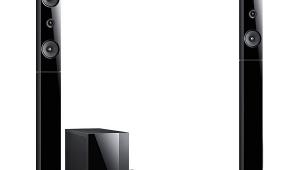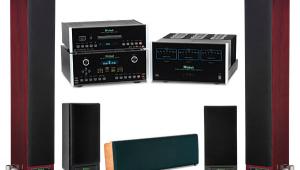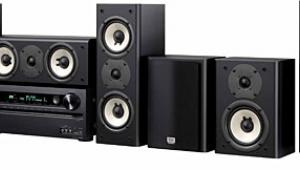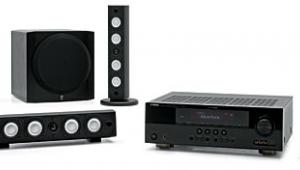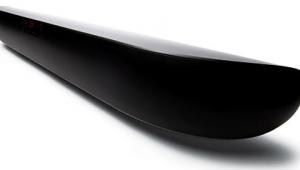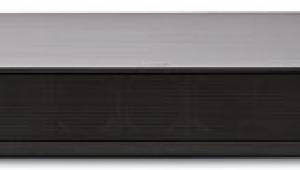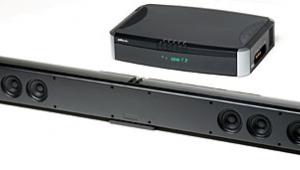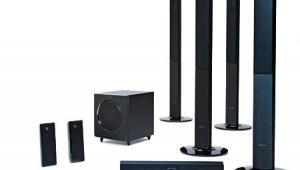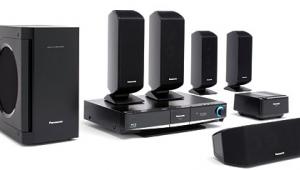MiCon Audio Evo-2 Home Theater System
![]() I was standing in an area of last year's Home Entertainment Show in New York that had no demonstration rooms anywhere nearby. It started with a boom and a rumble, like the gathering of a distant but powerful storm. It wasn't enough to shake me yet, but it was enough to grab my attention. Then came another boom, another rumble, and enough curiosity that I felt compelled to find a tactful way out of my conversation and make my way toward this growing intensity. Not only could I feel the floor moving under my feet as I got closer, but I even started to believe I was seeing Sheetrock flakes on the floor, steadily gathering into a distinct trail. Soon enough, the rattling of the walls, the low-frequency energy waves hammering my senses, and the shaken but excited looks of people coming the other way told me I had arrived. MiCon Audio, the door announced. Curious, I thought—or tried to think, before another sortie ripped out from inside—and a belief that the door might literally be blown off its hinges began to monopolize my thoughts. Finally, the door opened, and the answer to all of the riddles awaited me inside—but, for that, you'll have to read on.
I was standing in an area of last year's Home Entertainment Show in New York that had no demonstration rooms anywhere nearby. It started with a boom and a rumble, like the gathering of a distant but powerful storm. It wasn't enough to shake me yet, but it was enough to grab my attention. Then came another boom, another rumble, and enough curiosity that I felt compelled to find a tactful way out of my conversation and make my way toward this growing intensity. Not only could I feel the floor moving under my feet as I got closer, but I even started to believe I was seeing Sheetrock flakes on the floor, steadily gathering into a distinct trail. Soon enough, the rattling of the walls, the low-frequency energy waves hammering my senses, and the shaken but excited looks of people coming the other way told me I had arrived. MiCon Audio, the door announced. Curious, I thought—or tried to think, before another sortie ripped out from inside—and a belief that the door might literally be blown off its hinges began to monopolize my thoughts. Finally, the door opened, and the answer to all of the riddles awaited me inside—but, for that, you'll have to read on.
You probably have the same curiosity about MiCon Audio that I did, and rightfully so—it's a new name in the home theater ranks. MiCon is the brainchild of Michael Panicci and Constantine (Gus) Cossifos, two self-described regular guys who are home theater buffs first and foremost. But I can tell you that they know their way around A/V equipment better than the average buff. Their company was inspired by the now-defunct Cinepro Professional, but they are clearly looking to blaze their own trail by improving on Cinepro's amplifier line and building their own complete line of home theater gear. As they put it, "MiCon Audio surpasses the Cinepro tradition of excellence." Bold words, but then again, there's nothing shy about these two—or their equipment.
Set 'Em Up
![]() Three shows and three memorable shakings of my cage later, Michael, Gus, and a crate of truly impressive girth, stuffed to the gills, arrived at our studio door. Inside was 7.2 channels' worth of Evo-2 speaker system, a DTP-8 preamplifier/processor, one 3k6 Mk4 and one 4k6 Mk4 SE Gold amplifier, and an RC-30240 power unit. New touches and refinements had been added, but I soon discovered that the bombastic experience I had previously undergone was about to be fully re-created in our studio.
Three shows and three memorable shakings of my cage later, Michael, Gus, and a crate of truly impressive girth, stuffed to the gills, arrived at our studio door. Inside was 7.2 channels' worth of Evo-2 speaker system, a DTP-8 preamplifier/processor, one 3k6 Mk4 and one 4k6 Mk4 SE Gold amplifier, and an RC-30240 power unit. New touches and refinements had been added, but I soon discovered that the bombastic experience I had previously undergone was about to be fully re-created in our studio.
Until MiCon Audio's Reference system arrives, the Evo-2 is the company's newest speaker system. The front channels are two separate but magnetically coupled units. Each bottom unit houses two 8-inch woofers made of a proprietary carbon-wool composite (CWC) cone material in an MDF cabinet with a 1.5-inch-thick baffle and a proprietary bracing structure. Each top unit has two 6-inch drivers (one woofer, one midbass) and a 1-inch tweeter, also with the 1.5-inch-thick MDF baffle and proprietary bracing structure. Both the top and bottom units use Mundorf & Hovland crossover components, and each can be biamped (meaning the full front channel can be quad-amped) via top-quality binding posts. The center channel uses the same 1-inch tweeter, four of the same 6-inch drivers, and the same cabinet construction and bracing principles as the main speakers, and it can be quad-amped.
![]() The unique Evo-2 surround speakers use the 1-inch tweeter and two of the 6-inch woofers on each of its two angled front baffles. The baffles point the drivers down toward the listening position. The surround speakers' output patterns are a compromise between the principles of direct and bipolar radiation, but you can't switch between the two. These units can also be biamped. We used two of the Evo-2 subs, which each use two 12-inch cones in a push-pull, isobaric configuration. These subs are passive, with an external EQ module, but there are more than enough amp channels to go around in this system.
The unique Evo-2 surround speakers use the 1-inch tweeter and two of the 6-inch woofers on each of its two angled front baffles. The baffles point the drivers down toward the listening position. The surround speakers' output patterns are a compromise between the principles of direct and bipolar radiation, but you can't switch between the two. These units can also be biamped. We used two of the Evo-2 subs, which each use two 12-inch cones in a push-pull, isobaric configuration. These subs are passive, with an external EQ module, but there are more than enough amp channels to go around in this system.
The electronics are no less impressive. The DTP-8 pre/pro is decked out with more features than I have room to discuss here. Connections are ample, all major processing modes are aboard, except THX, and the sound is exactly what I like to hear from a pre/pro—no sound of its own at all. The amps are the heart of this system, and they are a big heart indeed. Both models crank out massive amounts of power across their six channels (450 watts each for the 3k6 Mk4 and 475 watts each for the 4k6 Mk4 SE Gold, into 8 ohms), using no less than 14 bipolar output transistors per channel. And both deliver current like few amps ever made. The fit and finish are top-shelf, as are the internal components. Feeding these amps is the RC-30240 power unit, a multi-talented device that conditions, protects, and provides a regulated 240 volts from two appropriate 120-volt feeds—most of us are stuck with one of these—which lets the amps truly show their mettle. This system's powerful presentation is highly impressive, to put it mildly.
Having heard what this system could do in a large showroom, I feared for the structural integrity of our modestly sized listening room. But into it the system went, with the front channels set about 3 feet out from the side and rear walls and toed-in slightly, and the center channel was mounted on a stand. I mounted the surround speakers roughly 2 feet above ear level—to take full advantage of the angled front face—on slick custom stands. The side speakers were set some 120 degrees from the listening position on the side walls, and the rear speakers sat along the back wall, about 3 feet apart. The front and center speakers got two amp channels, while the two subs and four surrounds each got single feeds. The Simaudio MOON Orbiter universal disc player chipped in as the source unit—about the only product category MiCon hasn't yet tackled.
Knock 'Em Down
Entering our listening room instantly generated flashbacks of entering the room in New York that first time, looking for an answer to the riddles. The answer is more than a home theater system but truly a home theater experience, especially when you crank it up. That might be the most amazing thing about this system. It can play at decibel levels that will make you fear for your eardrums' safety (in theory), but at no point is it harsh, forward, aggressive, or grating, as so many systems can be when pushed, even at far lower levels than these. To test this system, I couldn't resist starting with movies, the first being a startlingly realistic assault on Omaha Beach from Saving Private Ryan. I've watched this scene countless times, but I've never been able to experience it at these kinds of levels, nor could I unleash this kind of dynamic range without having to turn it down before the squads ever even hit the beach. Yet, even in the midst of this incredible display of raw power, the subtle details remained clearly intact. I've never heard dynamic range like this from a system yet.
![]()
The system's phenomenal dynamics, low-frequency impact, and clean resolution continued with anything I ran through it. This included intense scenes from Underworld, Hero, Terminator 3, and many more. The Blue Room scene from Hero perfectly displayed both ends of this system's spectrum. The slightest effects were clearly resolved and carefully placed within the massive soundstage, but, as the intensity picked up, I could absolutely feel the pressure in the room building, along with the excitement factor. Still, through all of this, there was no crowding, no compression or fatigue, and no low-frequency boom. The attack and decay of each speaker, subs included, was dead-on, and the realism that resulted is hard to qualify. Large explosions, like those that abound in Terminator 3 and The Matrix, were truly an experience. I could literally feel the massive waves of sound developing, releasing, and moving through me, only to fade away naturally and quietly.
If you still doubt me as to the full impact of a properly designed, high-output, capable center channel, then you'd better give this one a listen—it's as good as they get. No matter how much music and effects producers want to cram into this channel, and no matter how loud I played the system, I simply could not get this speaker to flinch, even for a second. I could have sworn it even winked at me once, mocking my attempts. Dialogue sounded full-bodied, pinpoint accurate, and entirely clean. Merely calling it intelligible hardly does it justice.
The front and surround speakers are no less impressive. It's almost a pity to cross these front speakers over—with movies or music—as they can certainly handle an impressive low-frequency load on their own. But, when freed up to concentrate on the frequencies above 80 hertz, they deliver a midrange impact that truly sets the stage. Speaking of stage, the speakers created one with two-channel music that was hard to believe, even within the relatively limited confines of our room. Pink Floyd's "Another Brick in the Wall" from the second Burmester collection has never sounded bigger, crisper, or more dominating in this room.
![]()
Whether with multichannel music or movie soundtracks, the big Evo-2 surrounds did an excellent job of walking the fine line of creating impact without calling undue attention to themselves. This was exemplified by Bucky Pizzarelli's Swing Live (SACD or DVD-Audio, Chesky), as good a recording of the live-jazz-club experience as you'll find. The surrounds only made themselves obvious during the exuberant cheering of the crowd between songs. While the music played, the surrounds adeptly re-created the full depth and ambiance of the room with all its spatial cues intact, but without really ever letting me know what they were up to. As with everything else in this system, they were the definition of subtlety and intensity, all at once.
From beginning to end, one word had dominated my thoughts about this system: intensity. This was the first word to enter my mind as I stood in the hallway that day at the show, and this is the last—and best—word I can think of to describe what MiCon Audio's Evo-2 system is all about. It delivers one of the most startlingly realistic home theater experiences you'll find anywhere. It's certainly not for the faint of wallet, but neither is a Ferrari. But, as with a Ferrari, don't let a large price tag get in your way of at least taking a test drive. Trust me: You will never forget the ride.
Highlights
• Intensity like you've never heard, but controlled and comfortable
• Dynamic range that doesn't quit
• Highly impressive, powerful presentation all around
